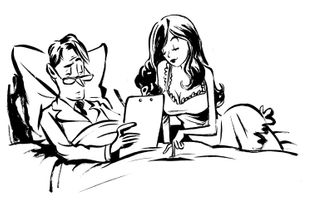
Human sexuality used to be perceived as a lot less fluid (and more intuitive) than we now know it to be. The more scientists learn about what turns us on — much of desire is sparked in our brains rather than our groins; aphrodisiacs can come from the most unlikely places — the less we can definitively say about it. Arousal is different for everybody, in other words, even among those who happen to be of the same gender identity or sexual orientation, and what’s true for an individual at one point in time is very likely to change as the years pass and relationships evolve (and innovations like so-called female Viagra — which this month got a big push for FDA approval — pop up). In spite of all the researchers these days attaching electrodes to genitals and forcing people to watch naked yoga, in some ways the sources and varieties of human pleasure remain as mysterious as ever.
1. Porn isn’t going to screw up your sex drive.
You’ve likely heard that pornography can be destructive for real-life relationships. Too much porn, the thinking goes, desensitizes the viewer to erotic images and makes it more difficult to become aroused in real-life sexy situations. Some have even claimed that men who frequently watch online porn are more likely to struggle with erectile dysfunction. Earlier this year, however, a pair of studies were published that found no correlation between porn viewing and erectile dysfunction. Other research has even suggested that both men and women with a casual porn habit report having more frequent and higher-quality sex compared with people who don’t watch porn.
2. Bisexual men tend to be more sexually adventurous over all than gay or straight men.
Previous research had suggested that bisexual men’s bodies respond more strongly to erotic images of men than to those of women, a finding that contributed to the (unfair and outdated) skepticism over whether bisexuality is a distinct sexual orientation. But a 2013 study highlighted a key characteristic that may explain why some bi men get turned on by women and some don’t: sexual adventurousness. Bisexual guys who are drawn equally to men and women tend to score higher in sexual curiosity — in other words, they show more interest in a wider range of sexual acts. The authors argue that this means that, even within the seemingly discrete category of “bisexual men,” there is a fair amount of sexual fluidity.
3. As viewers of The Kids Are All Right may remember, some lesbians like to watch gay-male porn.
In case you needed more proof that human sexuality is an often unpredictable thing, there’s a study by Irish and Canadian researchers in which they interviewed lesbians about their porn preferences. Most of the women quoted didn’t care for girl-on-girl porn, saying they found the films unrealistic and clearly made by and for straight men. (“For the guys, it’s like, Oh, make them both cute and femme, because they don’t want to have this masculine dyke in there,” said one woman after watching a clip from Lesbian Cheerleader Squad 2.) Instead, many lesbians are drawn to erotic films depicting two guys getting it on. That’s partially because women tend to have more erotic plasticity than men — that is, they’re turned on by a wider variety of things. Sex researcher Meredith Chivers has found, for example, that while men tend to show physical arousal only in response to erotic films depicting their stated sexual orientation, women show similar arousal patterns when watching clips from gay-male, lesbian, and straight pornography, regardless of their orientation. (Plus, with guy-on-guy porn, you don’t have the associated ickiness of women performing for a male audience.)
4. The (maybe) soon-to-be-approved “female Viagra” releases the brain’s sexual brakes.
The drug flibanserin, intended to treat low sexual desire in women, isn’t exactly the pink version of the little blue pill. Rather than pushing blood flow to the genitals, flibanserin targets key neurotransmitters that are involved in sexual response: dopamine, norepinephrine, and serotonin. The drug increases the amount of dopamine and norepinephrine, which are like the brain’s accelerators when it comes to sexual response; at the same time, it turns down the level of serotonin, which is responsible for inhibition. Since 2010, the FDA has twice shot down flibanserin. Each time, the drug manufacturers couldn’t prove to a review panel that the medication’s benefits were greater than the risks it posed. Flibanserin gets a third chance at approval this summer — this month, an advisory panel was convinced that flibanserin is safe to use for women taking antidepressants and that the drug does not impair driving; the FDA won’t make the final decision until August, but the committee’s vote is highly influential.
5. Many transgender men and women experience changes in their sexual desire as they transition.
About 71 percent of transgender men report an increase in desire after sex-reassignment therapy, according to a 2014 study in the Journal of Sexual Medicine. “Trans men take testosterone, and testosterone really, really will increase the sex drive,” said Stefan Rowniak, a nurse-practitioner and assistant professor at the University of San Francisco. The opposite is often true for transgender women, 62 percent of whom say their sexual desire drops after the therapy. And sometimes, but certainly not always, transgender people experience other changes in arousal while transitioning, such as whom they’re aroused by. A 2014 study by German researchers found that 33 percent of trans women and 22 percent of trans men reported a change in their sexual orientation after transitioning — that is, some were now attracted to men, or women, or both, in ways they weren’t before. Then again, plenty of post-transition transgender folks would prefer to keep sleeping with the same types of people as they did pre-transition — and for some, the sex gets much better. As one trans man told Rowniak about sex with his husband after transitioning, “The interesting part of being sexual with him as a man was [that it’s] much better than being sexual with him as a woman, even though the act was pretty much the same.”

6. Jerry Seinfeld was right: There’s good naked, and there’s bad naked.
Meredith Chivers is somewhat famous in her field for showing study subjects a wide range of visual stimuli in order to assess what kind of imagery tends to get people going. In one study, her human lab rats watched all sorts of films, including some of people exercising naked. Set to background music, those movies depicted a lone nude person doing yoga,calisthenics, or simply walking. These were the least popular of all the films, resulting in the weakest arousal response.
7. One percent of the population likely isn’t turned on by anything at all.
The science on asexuality has picked up lately. Last year, scientists at the University of British Columbia examined whether people who say they are asexual really just have extremely low sexual desire. They don’t. On the contrary, asexuality, like homosexuality or heterosexuality, seems to be a distinct sexual orientation. This year, that same research team developed a 12-item survey that, they argue, can identify asexuals. It’s called the Asexuality Identification Scale, or AIS for short, to mimic the nickname some asexuals give themselves: aces.
8. Zoophilia may be the most common uncommon turn-on.
Researcher Justin Lehmiller last year ran a survey for readers of his popular blog, Sex and Psychology, asking them to share the “most unusual” things that make them sexually aroused. As Lehmiller combed through the answers, a theme emerged: sexual attraction to animals, horses especially.
9. Oysters are a sham.
Although many foods have been touted as aphrodisiacs, there is little to no scientific evidence that any of them, including oysters, actually boost sexual desire. Most people who swear by aphrodisiacs have probably just experienced a change in sexual desire because they strongly believed that they would. Put that way, pretty much anything can be an aphrodisiac if you want it to be.
1. Time it takes to reach peak arousal.
Women: 12.4 minutes
Men: 11.07 minutes
*According to a McGill University study monitoring body heat emitted by the genitals of 28 men and 30 women while watching an erotic film clip. (Both the women and the men started getting turned on within 30 seconds.)
2. Ideal duration of foreplay.
Women: 18 minutes
Men: 18 minutes
*According to a study in the Journal of Sex Research of 152 heterosexual couples.
3. Frequency of masturbation.
Women: Five times a month
Men: 12 times a month
*According to a Medical College of Wisconsin survey of 223 college students.
4. Visual stimuli.
Women: No matter their sexual orientation, they show about the same level of physical arousal when watching erotic films depicting gay, lesbian, or heterosexual sex.
Men: Tend to physically and mentally respond in line with their sexual orientation: Straight guys are more likely to become erect in response to sexualized images of women, and gay guys are more likely to when viewing those of men.
*According to a University of Toronto study that monitored the genitals of the volunteers (via plethysmographs) and also allowed them to rate how aroused they felt.
5. Think about sex every day.
Women: 20%
Men: 53%
*According to a 1994 University of Chicago survey (the most recent national representation) of U.S. adults ages 18–59.
6. Always orgasm during sex with their partner.
Women: 29%
Men: 75%
*According to a University of Chicago survey of 3,342 Americans.
The problem: Monogamy.
When you’re with the same person for a long time, “there can be a rigidity to your sex life,” says Gail Saltz, M.D., author of The Ripple Effect: How Better Sex Can Lead to a Better Life. “We do it the same way every time. ‘I squeezed your boob. I touched your crotch. I come inside. I roll over and go to sleep.’ It’s almost like a habit rather than having any emotional content.”
The solution: Researchers have found that couples who were encouraged to think about sex as a means of improving their relationship — by making their partner happy or enhancing the intimacy between them — reported feeling more daily sexual desire, a result that maintained itself over the four-month period of the study. It’s called sexual communal strength, and it’s one of those examples of the counterintuitive and, frankly, selfish pleasures of giving.
The problem: The desire gap.
The way most people think about their libido goes like this: A particularly hot thought crosses your mind, or a particularly hot person crosses your path, and suddenly the urge to get it on hits you like a lightning bolt. Desire is indeed sparked in this out-of-the-blue way some of the time for some people, but, crucially, most of them are men. Emily Nagoski, Ph.D., the author of Come As You Are: The Surprising New Science That Will Transform Your Sex Life, terms this “spontaneous desire” and estimates that the libido operates like this for around 75 percent of men but only 15 percent of women.
The solution: Just do it. “A lot of women find that desire follows arousal, sort of like when you don’t realize you’re hungry before you take a bite of food,” says Charlie Glickman, Ph.D., a sex coach who blogs at makesexeasy.com. “The more that you don’t, the more that you won’t,” adds Saltz. “There does have to be a certain amount of ‘Tonight, we just are.’ ” (Which is not to suggest having sex when you don’t want to, but rather when you want to want to.) And for some people, the hottest turn-on is feeling like they’re the turn-on — a theory known as “object of desire self-consciousness.” The Canadian researchers who coined the term have found this may be especially true for women, who ranked “the way my partner looks at my body” above “the sight of my partner’s body” on the sexiness scale.
The problem: Out-of-control libido.
Your body can act turned on even if your brain isn’t into it. Lab studies show a 50 percent overlap between genital arousal and subjective arousal for men. For women, arousal in the body and brain coincide only 10 percent of the time. A good example of that brain-body disconnect: Women can get physically turned on from watching what is essentially chimp porn. When women in a recent study watched videos of bonobos having sex, their genitals responded — not as strongly as to human porn but more strongly than to a nonsexual film.
The solution: When the physical and mental aren’t lining up, try expanding what sex can be beyond simply genitals touching, says Glickman. “What kind of sex might feel good to you? Can he or she kiss and hold him while he masturbates? Reframe it so you can try to get that need met.” Using a sex toy can give you an alternative to intercourse, but Saltz says to ignore the newer models, like fingertip vibrators, and grab the tried-and-true Hitachi Magic Wand instead. “The problem with these teeny-weeny ones is that they don’t have much power,” she says.
The problem: Low T.
As men age, their testosterone levels drop, which supposedly decreases their libido. Researchers say that as many as 10 percent of men in their 40s experience this, and up to 80 percent of men older than 70 do. Testosterone can also plummet because of antidepressants such as Paxil and Prozac.
The solution: These men are often prescribed supplemental testosterone, which can reinstate their desire for sex. In the event that it doesn’t, notes Justin Lehmiller, remember that sexual desire is best thought of as depending on a combination of biological, psychological, and social factors — and low T may be just one piece of the puzzle.
Illustrations by Zohar Lazar
*This article appears in the June 8, 2015 issue of New York Magazine.
Things you buy through our links may earn Vox Media a commission






